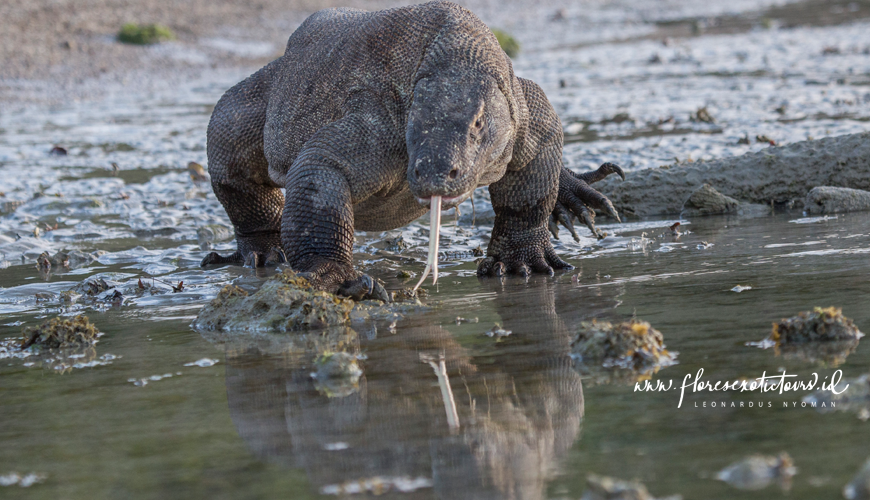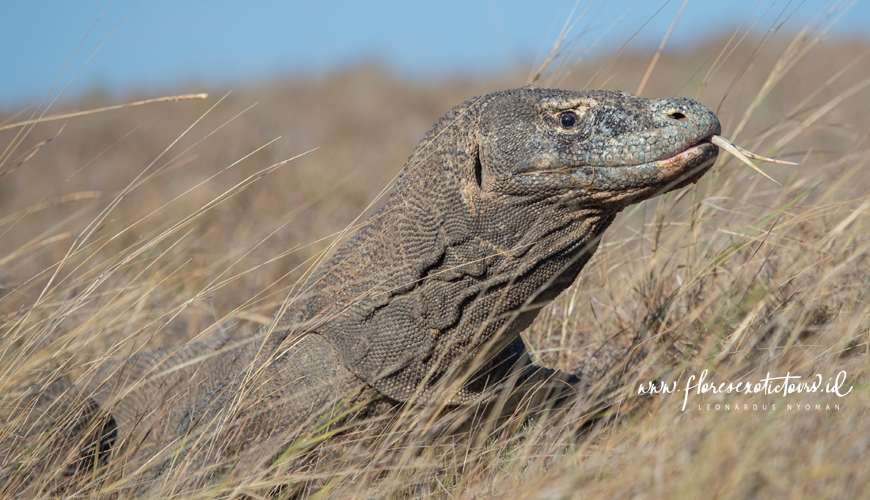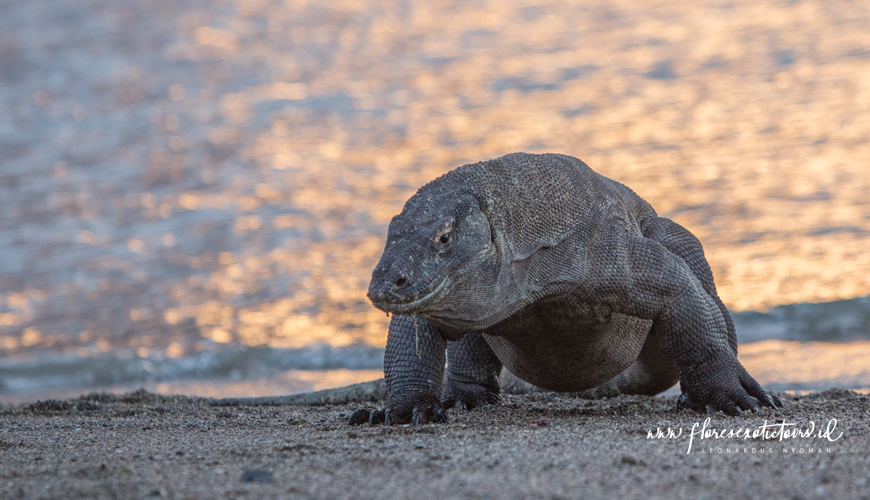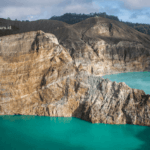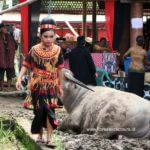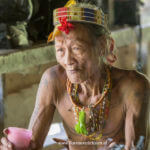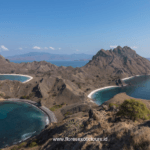The Komodo dragon, as befits any creature evoking a mythological beast, has many names. It is also the Komodo monitor, being a member of the monitor lizard family, Varanidae, which today has one genus, Varanus. Residents of the island of Komodo call it the ora. Among some on Komodo and the islands of Rinca and Flores, it is buaya darat (land crocodile), a name that is descriptive but inaccurate; monitors are not crocodilians. Others call it biawak raksasa (giant monitor), which is quite correct; it ranks as the largest of the monitor lizards, a necessary logical consequence of its standing as the largest lizard of any kind now living on the earth…. Within the scientific community, the dragon is Varanus komodoensis. And most everyone calls it simply the Komodo.” Claudio Ciofi
The Komodo dragon is an ancient species whose ancestors date back over 100 million years. The varanid genus originated between 25 and 40 million years ago in Asia. The Komodo descended from this species and evolved to its present form over four million years ago.
The Komodo is long-lived (as are most of the larger reptilian species) with an estimated life expectancy of over 50 years in the wild. In keeping with its longevity, the Komodo matures late in life, becoming sexually viable at five to seven years, and achieving maximum body density in fifteen years. Komodos are sexually dimorphous, which means males are bigger than females. The largest recorded specimen was 3.13 meters in length and was undoubtedly a male. Females rarely exceed 2.5 meters in length. What is perhaps more important, is that the characteristic bulk is achieved by older dominant males in clearly delineated territorial areas. As an adult Komodo can consume up to 80% of its body weight in one gorging, weight is a highly variable factor and is largely dependent on the most recent feeding. A typical weight for an adult Komodo in the wild is 70 kilograms.
Komodo dragons are first and foremost opportunistic carnivores, and predators second. Although the Komodo can sprint briefly at 20 kilometers an hour, it does not chase down the game as do the larger mammalian predators. The Komodo is a stealth predator, which lies motionless and camouflaged alongside game trails for the unwary, which tend to be the very young, the old and the infirm. In an attack, the Komodo lunges at its victim with blinding speed and clasps it with the serrated teeth of the jaw. Prey are rarely downed in the initial attack unless the neck is broken or carotid artery severed. The more likely outcome is escaped, followed by death a few hours or days later from septicemia introduced by the virulent strains of bacteria found in the saliva of the Komodo dragon (the Komodo survive primarily on carrion and ingest the bacteria when feeding).
The Komodo has two highly developed sensory organs – the olfactory and the Jacobson’s – which allow the dragon to detect rotting carcasses from distances as great as 10 kilometers. The yellow forked tongue is
constantly being flicked in and out of the mouth, “tasting the air”, and inserted into the Jacobson’s organ located in the roof of the mouth. The individual tips are highly sensitive and are capable of discriminating odors in the magnitude of millionths of a part. Using the information garnered the dragon wends in a seemingly random, winding path which becomes straighter the closer it approaches the carrion.
The Komodo is typically a communal feeder and any number of dragons might arrive at the site of the carcass. Socialization occurs during feeding at carrion sites, as does the mating. The abdomen is slashed first and the intestines and stomach contents scattered. Young juveniles roll in the fecal matter to mask their scent from aggressive adults, which attack and sometimes kill juveniles during feeding. The dominant male feeds until sated, followed by other dragons in order of size. While the dominant male is gulping down hindquarters and ribcages, the braver dragons chance foraging a few scraps. Virtually the entire carcass is consumed in the process– head, fur, hooves, and bones. After feeding, the Komodos become quiescent and approachable while their digestive tracts are converting the food into fat energy stored in the tail.
Between the months of May and August, mating occurs at and around feeding sites. As males outnumber females in a ratio of nearly four to one, the dominant male must fend off other suitors before mating. Males will engage in slashing, biting and bipedular rearing onto the tail until the dominant male is acknowledged by displays of subservience and the vanquished flees. The female is forced into a prone position while the male tongue flicks her body, and in particular, the fold between the torso and the rear leg close to the cloaca. With Komodos, the male hemipenes are located here as are the female genitalia. Once prone, the male mounts onto the back of the female and inserts one of the two hemipenes into her cloaca, depending on which side he is perched. The month of September is when a clutch of 15-30 eggs is buried in a nest dug with the powerful claws of the female dragon. A typical nesting site is in the composting vegetative mounds of the maleo birds which are indigenous to Komodo.
The gestation period for the eggs is eight to nine months. Hatchlings, which average 40 centimeters in length and weigh 100 grams, emerge from the nest in April and immediately scramble up the nearest tree to avoid being eaten by the adults. There are plenty of small lizards, insects, and mammals in the canopy after the brief rainy season in January and February to sustain the juveniles until they descend to the forest floor roughly a year later. This period of change between an arboreal and a terrestrial habitat, when the juveniles are a meter in length, is a time fraught with danger. The juvenile Komodo is just too bulky to safely ascend many trees, and not big enough to outrun a ravenous and determined adult. Cannibalism is a fact of life for this species, and perhaps is an evolutionary response to the harsh, arid climate of Komodo.
Prey species for the dragon on Komodo island include deer, boar, wild buffalo, the maleo bird, snakes, reptiles and small mammals. On Rinca, the monkeys and wild horses found there are also constitute prey, as do the goats raised by the local people. On the odd occasion, people are also attacked by the Komodo dragon. There have been eight recorded instances of attacks on humans since Komodo has become a national park, almost all of which occurred on Rinca.
Park Facilities
The Komodo National Park administrative offices are located in Labuan bajo in west Flores. An information center and travel agents where transportation to and from the Park can be arranged are also found in Labuan Bajo. The majority of tourists to the Park pass through the Loh Liang ranger station nestled in the sweeping arc of Slawi Bay on Komodo island. This is the largest facility in Komodo National Park with bungalows and rooms, a restaurant and a dormitory for the park rangers. The most popular tourist activity is a hike to the Banugulung viewing area, a two-hour roundtrip level walk that originates from Loh Liang. Hikes to other areas of Komodo are also possible and vary from one to two days: Gunung Ara, Poreng, Loh Sebita, Gunung Sata Libo, Soro Masangga. On longer walks, overnight accommodation can be arranged at ranger posts at Loh Sebita and Loh Genggo. For certified divers, there is a compressor and diving equipment available for hire at Loh Liang as well as masks and fins for snorkellers. Handicrafts made in the nearby village of Komodo are for sale at the arrival jetty.
The hiking on Rinca is less strenuous than that on Komodo and has the added attraction of viewing the wild horses and monkeys which are not found on Komodo. On Rinca wild buffalo are more common and easily seen as well. On the north side of the island, behind Rinca village, is a large cave with a resident bat colony. Rangers at both Loh Liang and Loh Buaya are readily available to lead walks and are knowledgeable about the local fauna and birdlife.
Conservation Status: Vulnerable
Scientific Classification:
Kingdom: Animalia
Phylum: Chordata
Class: Reptilia
Order: Squamata
Suborder: Sauria
Family: Varanidae
Genus: Varanus
Species: Varanus Komodoensis


